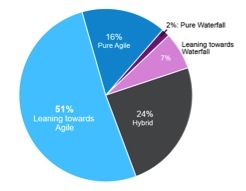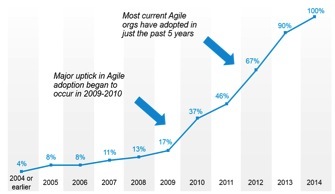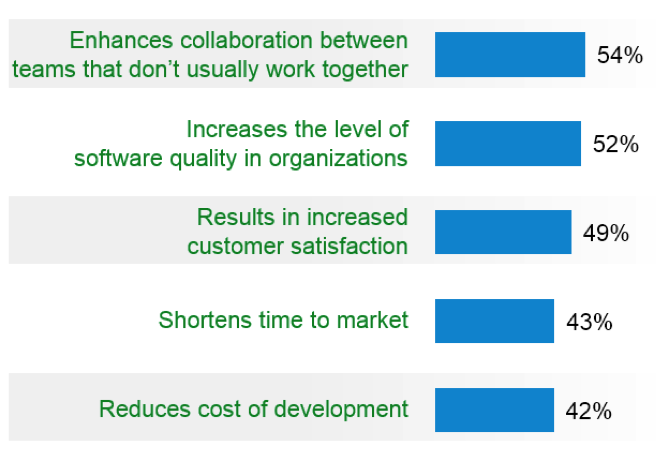A recent survey of development and IT professionals* shows that agile is now the norm. The majority of development teams and projects now embrace the methodology, while pure waterfall approaches are in the minority. The study consisted of an online survey of 601 software developers and IT professionals.
Agile software development entered the scene more than 15 years ago as a reaction to traditional approaches to software development projects. Originally promoted as a movement, many people viewed it as a challenger to entrenched practices such as waterfall.
Driven by a belief among adopters that this new style of development is more customer-centric and enhances team collaboration, the method was slow to start but quick to dominate, with most of the growth occurring in the last five years.
Pure agile organizations on the rise
The vast majority of organizations surveyed reported that they primarily use agile methods. In fact, two-thirds described their company as either "pure agile" or "leaning towards agile," as shown in Figure 1.

Figure 1: Primary development method used In organization across projects. Source: HP online survey of 601 development and IT professionals.
Even among the remaining one third of organizations that still use waterfall, the influence of agile methods can be felt. A hybrid approach is used by 24 percent of respondents, meaning that they incorporate at least some agile principles into the management of their software development projects. Only nine percent describe themselves as using "pure waterfall" or "leaning towards waterfall."
It's possible that some respondents were reacting to social pressure and over reported their use of agile methods. Even if this is the case, however, it only provides further evidence of its ascension. The widespread adoption of agile signals to others that issues such as team collaboration, efficiency, and customer satisfaction are being taken seriously.
An accelerating trend
Although agile methods were first introduced more than a decade ago, most organizations using agile only adopted the practice in the past five years. Based on this information, the survey shows that agile adoption reached an inflection point between 2009 and 2010.
The adoption of agile seems to follow the typical diffusion of innovation into a marketplace. As shown in Figure 2, agile showed slow incremental growth through 2008 and then sharply accelerated growth once it began to gain traction in the market.

Figure 2: Agile adoption over time (number = 475 respondents with some adoption of agile methods).
Multi-generational movement
One might expect that agile adoption would be most prevalent among younger developers, and the study does support that conclusion. Respondents between the ages of 24 and 34 were more likely to report using it than those in other age groups, and three quarters of respondents in this group described themselves as doing pure agile or leaning towards agile, as shown in Figure 3.

Figure 3: Primary development method used in organization across projects—by age group. See Figure 1 above to view labels for each color-coded pie slice.
However, it would be misleading to consider agile simply a movement of the young. Half of the respondents in the oldest age bracket classified their organizations as either pure agile or leaning agile. Younger developers may be the most avid adopters, but the movement is pervasive across all types of organizations.
Three key motivators
Why have so many organizations moved to agile? To answer this question, researchers asked agile adopters to describe their beliefs about its adoption and consequences, as shown in Figure 4.

Figure 4: Percent of respondents agreeing with statement about agile development (number = 403 organizations that have primarily adopted agile).
The primary motivators for agile adoption were improving team collaboration and increasing software quality and customer satisfaction. These factors, not efficiency gains, were seen as the strongest benefits associated with the methodology.
__________________________________
* About this research
HP recently interviewed 601 development and IT professionals using a 15-minute online survey.
Profile of respondents
- Position: 401 professional developers and 200 IT Professionals recruited from a panel of IT B2B employees
- Size of business: 32 percent small organizations (10-99 employees), 31 percent medium organizations (100-999) and 37 percent large organizations (1000+)
- Age range: 24 to 65
Key topic areas
- Primary development methodology used in organization and most recent project
- Time frame for agile adoption (among those using agile)
- Perceptions/beliefs about agile development
Keep learning
Take a deep dive into the state of quality with TechBeacon's Guide. Plus: Download the free World Quality Report 2022-23.
Put performance engineering into practice with these top 10 performance engineering techniques that work.
Find to tools you need with TechBeacon's Buyer's Guide for Selecting Software Test Automation Tools.
Discover best practices for reducing software defects with TechBeacon's Guide.
- Take your testing career to the next level. TechBeacon's Careers Topic Center provides expert advice to prepare you for your next move.


